Description and Requirements
The Book
Bibliography
Syllabus
 Introduction
Introduction The Great Pyramid
The Great Pyramid Music of the Spheres
Music of the Spheres Number Symbolism
Number Symbolism Polygons and Tilings
Polygons and Tilings  The Platonic Solids
The Platonic Solids  Roman Architecture
Roman Architecture  Number Symbolism
in the Middle Ages
Number Symbolism
in the Middle Ages  The Wheel of Fortune
The Wheel of Fortune  Celestial Themes in Art
Celestial Themes in Art  Origins of Perspective
Origins of Perspective  What Shape Frame?
What Shape Frame?  Piero della Francesca
Piero della Francesca  Leonardo
Leonardo  Façade measurement by Trigonometry
Façade measurement by Trigonometry  Early Twentieth Century Art
Early Twentieth Century Art  Dynamic symmetry & The Spiral
Dynamic symmetry & The Spiral  The Geometric Art of M.C. Escher
The Geometric Art of M.C. Escher  Later Twentieth Century Geometry Art
Later Twentieth Century Geometry Art  Art and the Computer
Art and the Computer  Chaos & Fractals
Chaos & Fractals
Polygons, Tilings,
&
Sacred Geometry
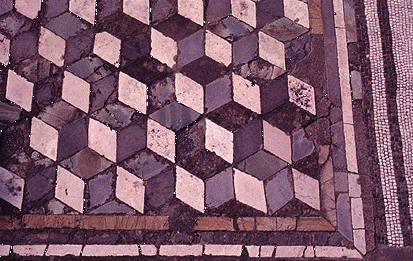
Slide 5-1: Pompeii pavement
Calter photo
In the last unit, Number Symbolism, we saw that in the ancient world certain numbers had symbolic meaning, aside from their ordinary use for counting or calculating.
In this unit we'll show that the plane figures, the polygons, triangles, squares, hexagons, and so forth, were related to the numbers (three and the triangle, for example), were thought of in a similar way, and in fact, carried even more emotional baggage than the numbers themselves, because they were visual. This takes us into the realm of Sacred Geometry.
For now we'll do the polygons directly related to the Pythagoreans; the equilateral triangle (Sacred tetractys), hexagon, triangular numbers, and pentagram. We'll also introduce tilings, the art of covering a plane surface with polygons.
| Outline: | Polygons |
| EquilateralTriangle | |
| Tilings | |
| Hexagon & Hexagram | |
| Pentagon & Pentagram | |
| Golden Triangle | |
| Conclusion | |
| Reading | |
| Projects |
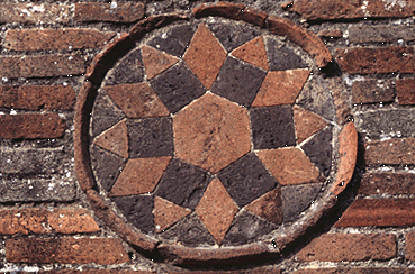
Slide 5-23: Design at Pompeii
Calter photo
In the last unit, Number Symbolism we saw that in the ancient
world certain numbers had symbolic meaning, aside from their ordinary
use for counting or calculating. But each number can be associated with
a plane figure, or polygon (Three and the Triangle, for
example).
In this unit we'll see that each of these polygons also had symbolic
meaning and appear in art motifs and architectural details, and some can
be classified as sacred geometry.
A polygon is a plane figure bounded by straight lines, called the
sides of the polygon.
From the Greek poly = many and gon = angle
The sides intersect at points called the vertices. The angle
between two sides is called an interior angle or vertex
angle.
Regular Polygons
A regular polygon is one in which all the sides and interior angles are equal.
Polygons vs. Polygrams
A polygram can be drawn by connecting the vertices of a polgon. Pentagon & Pentagram, hexagon & hexagram, octagon & octograms
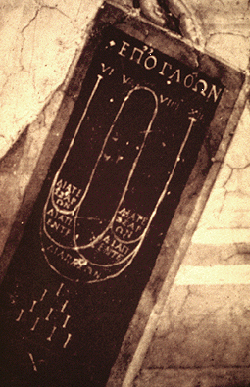 |
Slide 5-2: Tablet in School of Athens, showing Tetractys
Bouleau |
There are, of course, an infinite number of regular polygons, but we'll
just discuss those with sides from three to eight. In this unit we'll
cover just those with 3, 5, and 6 sides. We'll start with the
simplest of all regular polygons, the equilateral triangle.
Sacred Tetractys
The Pythagoreans were particularly interested in this polygon because
each triangular number forms an equilateral triangle. One special
triangular number is the triangular number for what they called the
decad, or ten, the sacred tetractys.
Ten is important because it is, of course, the number of fingers. The
tetractys became a symbol of the Pythagorean brotherhood. We've seen it
before in the School of Athens.
Trianglular Architectural Features
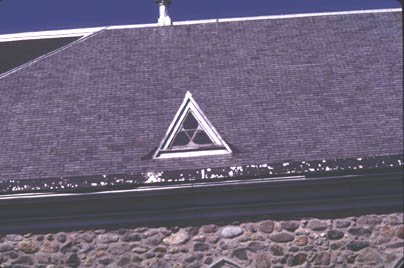
Slide 8-11: Church window in Quebec
In architecture, triangular windows are common in churches, perhaps representing the trinity.
Triskelion, Trefoil, TriquertaOther three-branched or three-comered designs include the triskelion.
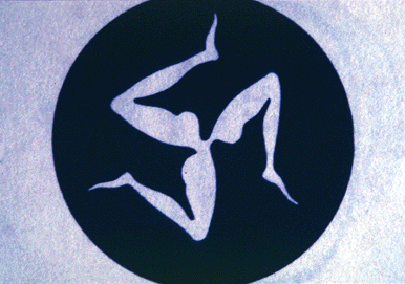
Slide 5-3: Greek Triskelion: Victory and Progress
Lehner, Ernst. Symbols, Signs & Signets. NY: Dover, 1950 p. 85
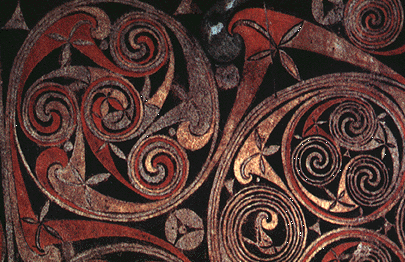
Slide 5-4: Irish Triskelions from Book of Durrow.
Met. Museum of Art. Treasures of Early Irish Art. NY: Met. 1977
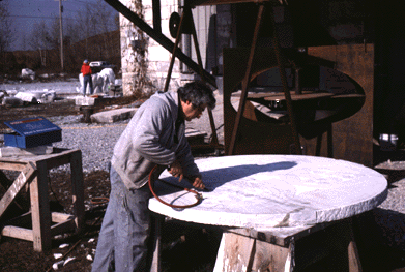 |
Slide 5-5: Calter carving Mandala II
Calter photo |
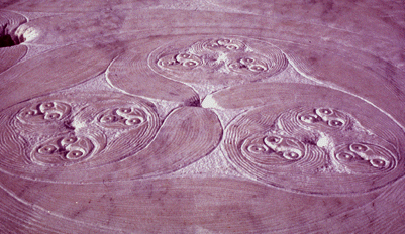 |
Slide 5-6: Closeup of wheel
Calter photo |
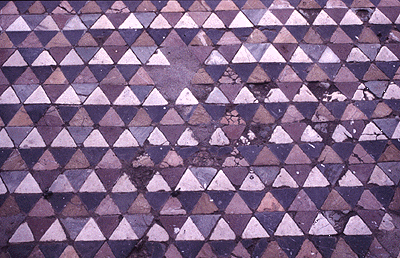 |
Slide 5-7: Pompeii Tiling with equilateral triangles
Calter photo |
Tilings or tesselations refers to the complete covering of a plane surface by tiles. There are all sorts of tilings, some of which we'll cover later. For now, lets do the simplest kind, called a regular tiling, that is, tiling with regular polygons.
This is opposed to semiregular tilings like the Getty pavement shown here.
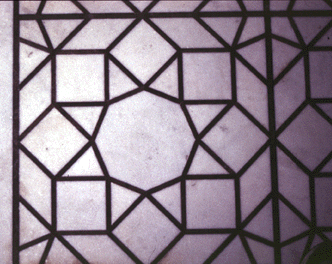 |
Slide 5-8: Getty Pavement
Calter photo |
The equilateral triangle is one of the three regular polygons that tile a plane. the other two being the square and hexagon.
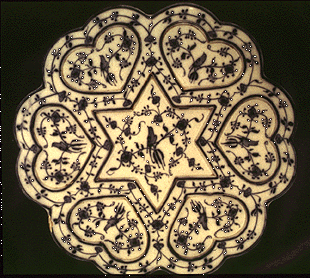 |
Slide 5-15: Plate with Star of David
Keller, Sharon. The Jews: A Treasury of Art and Literature. NY: Levin Assoc. 1992 |
Hexagonal Tilings
Our next polygon is the hexagon, closely related to the equilateral triangle
The hexagon is a favorite shape for tilings, as in these Islamic
designs, which are not regular tilings, because they use more than one shape.
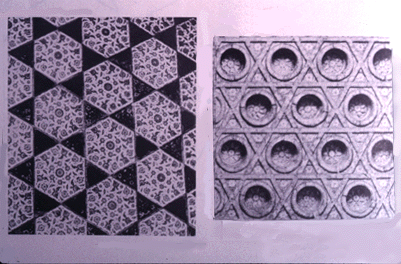
Slide 5-9: Islamic Tiling Patterns
El-Said, Issam, et al. Geometric Concepts in Islamic Art.
Palo Alto: Seymour, 1976. p. 54
But, as we saw, the hexagon is one of the three regular polygons will make a regular tiling.
An Illusion
The hexagon is sometimes used to create the illusion of a cube by connecting every other vertex to the center, forming three diamonds, and shading each diamond differently.
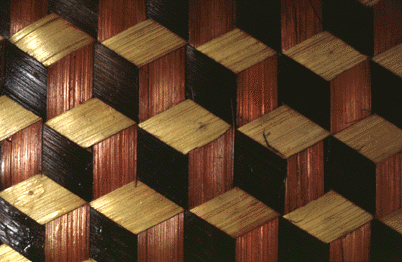 |
Slide 5-10: Basket
Calter photo |
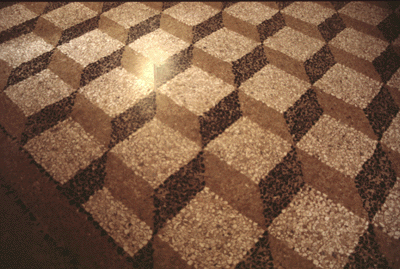 |
Slide 5-11: Pavement, Ducal Palace, Mantua
Calter photo |
The Hexagon in Nature
The hexagon is found in nature in the honeycomb, and some crystals such as basalt, and of course, in snowflakes.
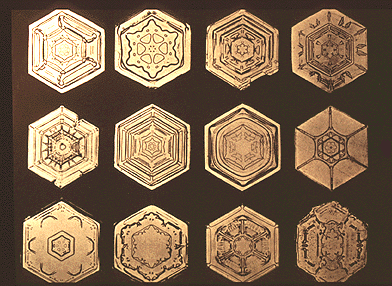 |
Slide 5-12: Snowflakes
Bentley, W. A. Snow Crystals. NY: Dover, 1962. |
Six-Petalled Rose
The hexagon is popular in architectural decoration partly because it is
so easy to draw. In fact, these are rusty-compass constructions,
which could have been made with a forked stick.
Six circles will fit around a seventh, of the same diameter, dividing
the circumference into 6 equal parts, and the radius of a circle exactly
divides the circumference into six parts, giving a
six petalled rose.
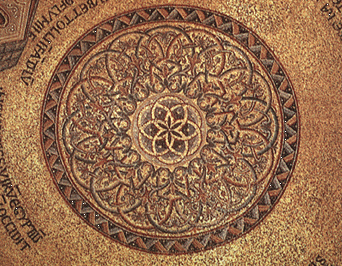 |
Slide 5-13: Moses Cupola. S. Marco, Venice
Demus, Otto. The Mosaic Decoration of San Marco, Venice. Chicago: U. Chicago, 1988. plate 60. |
Hexagon vs. Hexagram
Connecting alternate points of a hexagon gives a hexagram, a six-pointed star, usually called the Star of David, found in the flag of Israel.
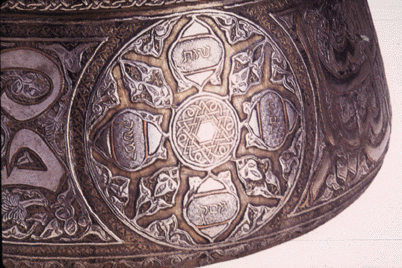
Slide 5-14: Star of David on Silver bowl from Damascus.
Jewish Museum (New York, N.Y.), Treasures of the Jewish Museum.
NY: Universe, 1986. p. 61
Solomon's Seal
The hexagrarn is also called a Solomon's Seal. Joseph Campbell says that King Solomon used this seal to imprison monsters & giants into jars.
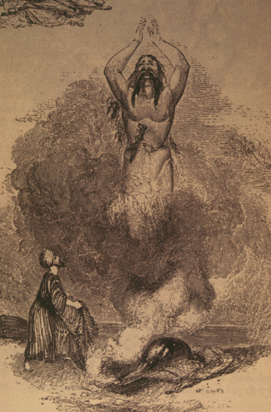 |
Slide 5-17: The genii emerging.
Burton, Richard. The Arabian nights entertainments. Ipswich : Limited Editions Club, 1954. |
The U.S. Great Seal
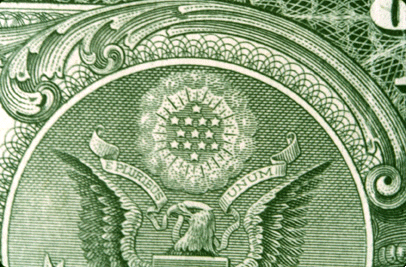 |
Slide 5-20: Seal on Dollar Bill
Calter photo |
The hexagrarn can also be viewed as two overlapping Pythagorean tetractys.
Joseph Campbell writes; In the Great Seal of the U.S. there are two of these interlocking triangles. We have thirteen points, for our original thirteen states, and six apexes: one above, one below, andfour to thefour quarters. The sense of this might be thalftom above or below, orftom any point of the compass, the creative word may be heard, which is the great thesis of democracy.
- The Power of Myth. p.27
Hexagonal Designs in Architecture
Hexagonal designs are common in ancient architecture, such as this church window in Quebec.
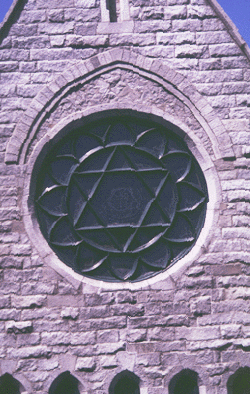 |
Slide 5-22: Church Window in Quebec
Calter photo |
This marvelous design is at Pompeii. It is made up of a central hexagon surrounded by squares, equilateral triangles, and rhombi.

Slide: 5-23. Design at Pompeii
Calter photo
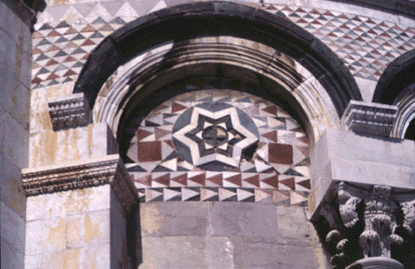
Slide 5-24: Design on Pisa Duomo
Calter photo
This hexagram is one of countless designs on the Duomo in Pisa.
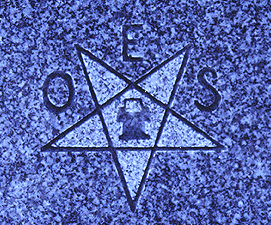 |
Slide 5-26: Pentagram from grave marker
Calter photo |
The Pentagram was used as used as a sign of salutaton by the Pythagoreans, its construction supposed to have been a jealously guarded secret. Hippocrates of Chios is reported to have been kicked out of the group for having divulged the construction of the pentagram.
The pentagram is also called the Pentalpha, for it can be thought of as constructed of five A's.
Euclid's Constructions of the Pentagon
Euclid gives two constructions in Book IV, as Propositions 11 & 12. According to the translator T.L. Heath, these methods were probably developed by the Pythagoreans.
Medieval Method of Construction
Supposedly this construction was one of the secrets of Medieval Mason's guilds. It can be found in Bouleau p. 64.
Durer's Construction of the Pentagon
Another method of construction is given in Duret's "Instruction in the Measurement with the Compass and Ruler of Lines, Surfaces and Solids," 1525.
Its the same construction as given in Geometria Deutsch, a German book of applied geometry for stonemasons and
Golden Ratios in the Pentagram and Pentagon
The pentagon and pentagram are also interesting because they are loaded with Golden ratios, as shown in Boles p.48.
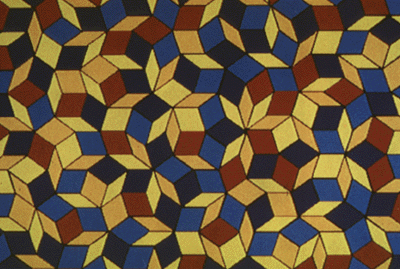
Slide 5-28: Emmer, plate F3
Emmer, Michele, Ed. The Visual Mind: Art and Mathematics.
Cambridge: MIT Press, 1993.
The Golden Triangle
A golden triangle
also called the sublime triangle, is an isoceles triangle whose ratio of leg to base is the golden ratio.
It is also an isoceles triangle whose ratio of base to leg is the golden ratio, so there are two types: Type I, acute, and type II, obtuse.
A pentagon can be subdivided into two obtuse and one acute golden triangle.
Euclid's Construction
Euclid shows how to construct a golden triangle. Book IV, Proposition 10 states, "To construct an isoceles triangle having each of the angles at the base the double of the remaining one."
Penrose Tilings
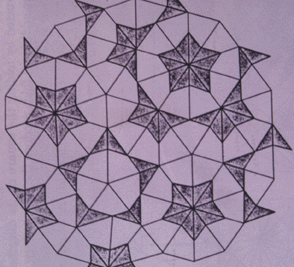 |
Slide: 5-27: Penrose Tilings.
Kappraff, Jay. Connections: The Geometric Bridge between Art & Science. NY: McGraw, 1990. p. 195 |
One place that the golden triangle appears is in the Penrose Tiling, invented by Roger Penrose, in the late seventies. The curious thing about these tilings is they use only two kinds of tiles, and will tile a plane without repeating the pattern.
Making a Penrose Tiling A Penrose tiling is made of two kinds of tiles, called kites and darts. A kite is made from two acute golden triangles and a dart from two obtuse golden triangles, as shown above.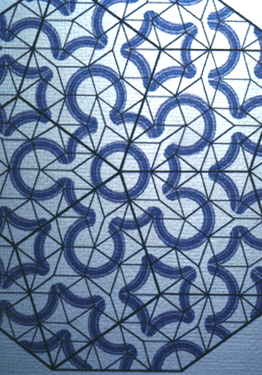 |
Slide 5-29: NCTM Cover |
So we covered the triangle, pentagon, and hexagon, with sides 3, 5, and 6. We'll cover the square and octagon in a later unit.
Its clear that these figures, being visual, carried even more powerful emotional baggage than the numbers they represent.
Next time we'll again talk about polygons, in particular the triangle. But I won't waste your time with some insignificant and trivial fact about the triangle, but will show that, according to Plato, triangles form the basic building block of the entire universe!
Joseph Campbell, The Power of Myth, pp. 25-29Projects
Carl Jung, Man andHis Symbols, pp. 266-285
Euclid, Elements, V2, pp. 97-104
Kappraff, Connections, pp. 85-87, 195-197
Fisher, p. 92-94
Cut a circle from paper, fold in quarters vertically, then again horizontally, making a 4 x 4 grid. 2 All these figures can be folded
see Magnus Wenninger,Mathematics Through Paper FoldingFold an equilateral triangle using NCTM method
4 Construct a hexagon with compass 8 Construct a hexagon by paper folding, NCTM method 8 Construct a hexagon by folding a circle 8 Make a pentagram by extending the sides of a pentagon, or make a pentagram by connecting the vertices of a pentagon 12 Construct a pentagon by either of Euclid's methods. Connect the vertices to make a pentagram. 13 Construct a pentagon by the Medieval method. Connect the vertices to make a pentagram 14 Construct a pentagon by Durer's method 14 Check for in the pentagon by using
dividers
14 Solve the five-disk problem, Huntley p. 45 14 Put one type I and two type 11 golden triangles together to form a pentagon 15 Construct a triangle by Euclid's method 16 Construct a kite and a dart. Make xerox copies. Use them to make a Penrose tiling. 17
